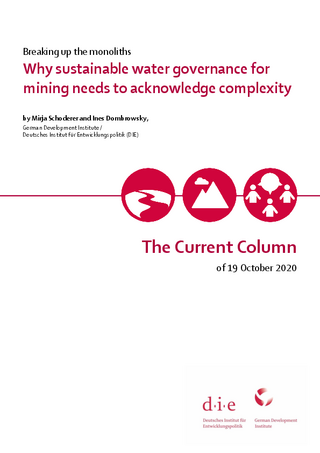Breaking up the monoliths
Why sustainable water governance for mining needs to acknowledge complexity
Schoderer, Mirja/ Ines DombrowskyThe Current Column (2020)
German Development Institute / Deutsches Institut für Entwicklungspolitik (DIE), The Current Column of 19 October 2020
Mining companies are increasingly aware that they need to manage their water risks better and to increase dialogue at eye-level with communities. Yet, water resource degradation from mining and conflicts with communities persist. One of the reasons might be that we are failing to grasp opportunities for and obstacles to cooperation by thinking about communities, companies and state agencies in too simplistic terms.
What is at stake?
Environmental issues are the number one cause of conflict between mining companies and communities. Similarly, the lack of a social license to operate – the acceptance of a mine by surrounding communities – has topped the list of business risks in EY’s survey of mining representatives for the second year in a row. Mining conflicts have increased steadily over the last two decades and the Global Environmental Justice Atlas currently lists almost 900 conflicts related to the extraction of minerals and metals. Roughly 85 percent of these name surface or groundwater depletion or degradation as key points of contention. Rising demands in certain minerals – such as lithium for electro-mobility – increase extractive activities and put further pressure on water resources.
How water resources are governed touches on key topics of the 2030 Agenda for Sustainable Development, among them clean water and sanitation, good health and wellbeing, reducing inequalities, and sustainable consumption and production. The potential impacts of mining include dam breaks, heavy metal contamination, and the disproportionate allocation of water to private companies in water scarce areas. Often, population groups that find their health, livelihoods and cultural practices threatened by water resource degradation already experience marginalization while benefits from mining tend to accumulate in the hands of elites. On the other hand, mining companies can also improve local water infrastructure and provide employment in rural areas, while producing raw materials for global supply chains.
How have solutions looked so far?
At the 10th Dialogue on Water, practitioners and academics interested in water, mining and development came together online on October 8 and 9 to discuss how negative effects from mining on water resources and on the people who rely on them can be mitigated. Numerous procedures to that end have been devised. Some of them put state agencies in charge of implementing them, for example regulations on environmental impact assessments or mining licensing. Others build on voluntary compliance by companies, like certification schemes or due diligence guidelines. Rarely, however, are these procedures implemented exactly as stipulated, or are as effective as anticipated in promoting environmentally and socially just practices.
A key reason behind that is multiplicity. For one, water itself is multiple, as keynote speaker Fabiana Li noted: while it is an economic good for some, others conceive of rivers, lakes and other water bodies as living entities, which hold rights of their own, such as the right to exist, persist, maintain and regenerate their vital cycles. Such fundamental differences in what water is can make negotiations difficult or cause unforeseen conflicts. For example, when chemical water quality is still within safe parameters after the discharge of mining wastewater but alterations to color or smell are already seen as harmful to the living entity water. As water shapes social relations and in turn is shaped by them, corporate social responsibility programs that influence water management practices can also produce unintended effects, such as new inequalities among community members.
Furthermore, each actor is multiple. Mining companies, for example, consist of various departments that act according to different performance metrics and disciplinary ethics, which lead them to pursue diverging goals. Often, dialogue between departments is lacking, so that risks that are identified in one department remain unacknowledged in another, as keynote speaker Nadja Kunz noted. State agencies are frequently tasked with contradictory roles, such as promoting mineral extraction while monitoring environmental compliance at the same time. Finally, communities rarely pursue one single set of goals in unanimous agreement. Instead, multiple forms of positioning towards mining operations co-exist, which come to the fore when community members engage with companies to discuss and negotiate water resource use.
What does that imply?
Research and policy interventions have long had a tendency to treat communities, companies and states as monoliths, glossing over the frictions that multiplicity produces. However, interventions and research that start from the insight that companies, communities and state agencies are themselves a set of social relations might more easily be able to identify entry points for dialogue and areas of connection across actors. They can also spot contentious issues early on, contextualise and address them. Committing to the complex-ity involved in water and mining governance is thus to take a first step towards more lucid cooperation between compa-nies, communities and state agencies.



